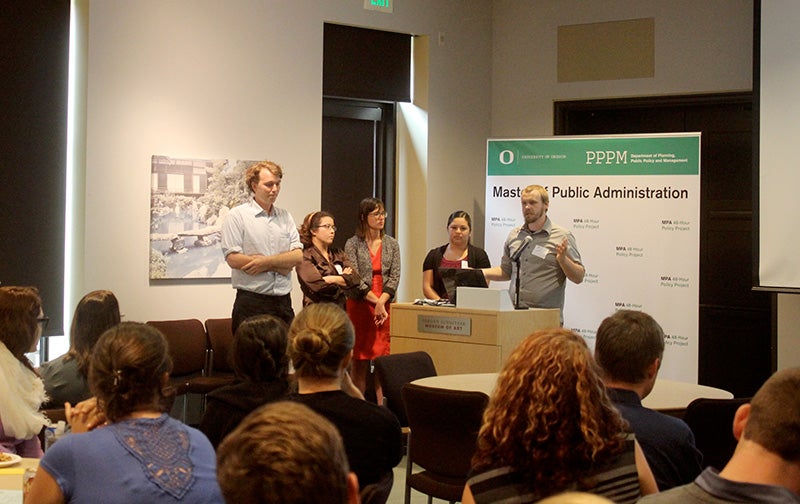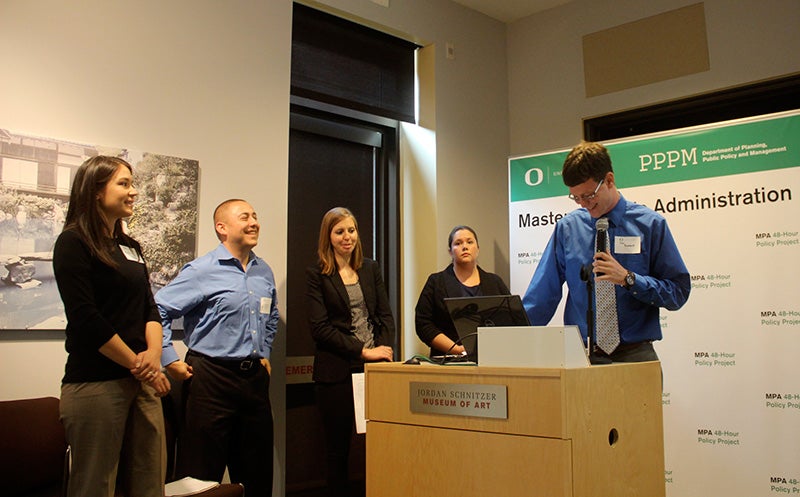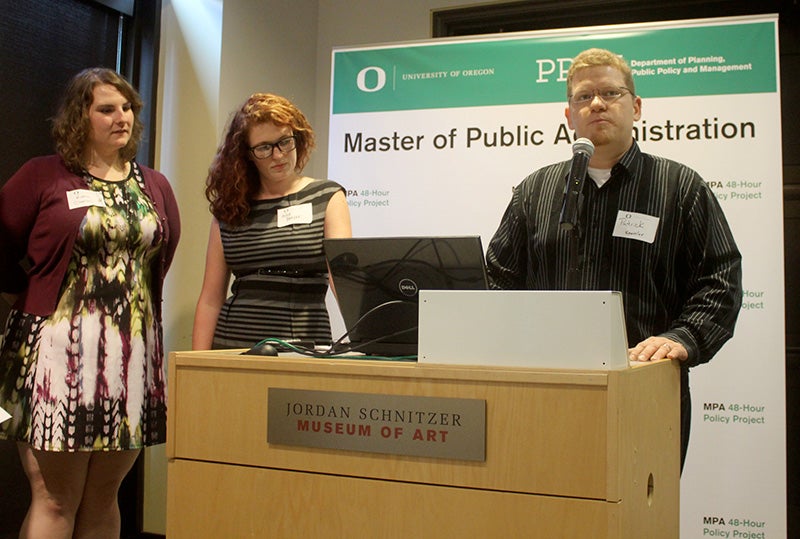The potential of tuition-free community college and toxic chemical regulation reform were among the issues addressed in late September by students from the Department of Planning, Public Policy and Management.
Presentations from the 48-hour Policy Analysis Project, now in its sixth year, took place at noon on Friday, Sept. 26 in the Jordan Schnitzer Museum of Art’s Ford Hall. Second-year graduate students from the master of public administration (MPA) program were asked to look very specific public-sector problems and present their findings based on their evaluations. Starting on Wednesday, Sept. 24, students had 48 hours to analyze, evaluate, make recommendations, and create their presentation.
“If you’re only in the classroom and all you get is theory and perfect cases where you can read every word and make all these perfect judgments based on certain assumptions, it’ll only take you so far,” says Renee Irvin, PPPM associate professor. “You need the context of applying this stuff in a messy situation. This exercise … pushes people into a realistic, messy situation where they have to cope with the restraints, muddle through, and do the best they can.”

Above: (from left) Alex Macfarlan, Masouma Zargar, Liz Rickles, Danielle Bautista, and Chris Holland present their policy analysis on reforming toxic chemical regulations on Friday, Sept. 26 in the Jordan Schnitzer Museum of Art’s Ford Hall.
The project, which takes place each year the week prior to the start of classes, allows for MPA program students to take a hands-on approach in policymaking with a time constraint familiar to the professional workplace. Issues addressed this year included tuition-free community college, reforming toxic chemical regulations, and energy efficiency rebates.
Daniel Bautista, Chris Holland, Alex Macfarlan, Liz Rickles, and Masouma Zargar worked on a presentation for reforming toxic chemical regulations.
In the presentation, Rickles asked who in the room was familiar with the dangers of asbestos? Hexane? Hexetidine? She explained that asbestos was widely used as construction material for roughly a century as a fire retardant, but inhaling the fibers causes lung disease. Hexane, an industrial cleaner agent, has been linked to permanent nerve damage. Hexetidine, on the other hand, is a perfectly safe ingredient in toothpaste.
“There’s tens of thousands of chemicals out there, and as consumers, we don’t know their dangers personally,” said Rickles in her group’s presentation. “Even if we were all PhDs in chemistry, we wouldn’t understand all the risks. That’s why it’s essential for the government to label, control, or ban these products.”
Rickles says that her team worked well together and the work was efficiently distributed. She adds that she the experience will allow her to tackle relevant challenges in the future.
“The way I see it is that if a potential employer in an interview ever asks, ‘Tell me about an example where you worked on a deadline,’ I’ll have a really solid demonstration of that skill,” says Rickles, who serves as a graduate teaching fellow for the Sustainable Cities Initiative. “I feel like I developed that skill through this process.”

Above: (from left) Holly Mar, Luis Sandoval, Kayleigh Frater, Maria Cortez, and Jonathan Bennett. Bennett speaks for the group’s findings on analysis of a potential tuition-free community college system on Friday, Sept. 26 in the Jordan Schnitzer Museum of Art’s Ford Hall.
The second group, made up of Jonathan Bennett, Maria Cortez, Kaylie Frater, Holly Mar, and Luis Sandoval, was assigned the topic of tuition-free community college. Policymakers in several states including Oregon have considered proposals to make community college tuition free. The program’s consequences would include both budgetary issues, improvement of college graduation rates, and potentially addressing some issues surrounding poverty and income inequality.
The alternative to tuition-free community college, the group argued, would be expanding Oregon Opportunity Grants, as only 18.6% of eligible students received grants in 2012.
Another statistic illustrated the inverse relationship between the level of educational degree (from high school diploma to PhD) and the unemployment rate. The more advanced the degree, the lower the unemployment rate.
Bennett says that the experience’s 48-hour time limitations helped prepare him for his professional ambitions as an environmental policy analyst.
“The tight time constraint put me out of my comfort zone, but being able to overcome that difficulty with my group was very rewarding,” he says.

Above: (from left) Katie Gatlin, Alexandra Breyer, and Patrick Sponsler present their group’s policy analysis on energy efficiency rebates on Friday, Sept. 26 in the Jordan Schnitzer Museum of Art’s Ford Hall.
Alexandra Breyer, Amanda D’Souza, Daniel Eubank, Katie Gatlin, and Patrick Sponsler were in the third and final group, which addressed the issue of how to reform the administration of rebates by the Public Utilities Commission through the Energy Trust of Oregon.
State law requires that any energy efficiency measures subsidized must be cost-effective. However, the changing energy landscape, including the record low price of natural gas, has had an impact on the investment returns and many measures may no longer be cost-effective.
Gatlin says that preparing for the presentation allowed the team members to work dynamically and focus on the strengths they developed during the first year of the program. She adds that the presentation promoted her confidence in conveying personal research before a critical audience.
“We knew going into the presentation that people would ask us hard questions to make sure our analysis is strong, which makes you work harder and consider all angles,” she says. “That being said, it's incredibly helpful and constructive. [On] Friday, we were in a room full of people who want us to succeed.”
Gatlin aspires to work within an organization that “promotes a healthy and engaged community."
“While I do not intend to go into policy analysis, being able to understand policy decisions will be a huge advantage as I move forward with my career,” she says.
Students are given less guidance on how to address their topics than they would receive in a normal classroom setting, says Grant Jacobsen, PPPM assistant professor of the project. A professional workplace environment is simulated over the 48 hours.
“It helps give them more experience working on a policy issue in a team-setting and under a tight timeline, which is an important skill for their careers.”
